Technologies That Enable Congestion Pricing—A Primer
Primary Tolling and Pricing-System Components
The following sections describe the primary system technologies and provide examples of locations where they are being used. Along with the more advanced technologies, this list also includes basic systems such as paper-based and manual facilities. This is partly for completeness, but it is also to assist in better illustrating and describing the basic functions for a simple system that will improve understanding through the later more complex options.
Paper-Based Systems
Paper-based systems require road users, who wish to use (or keep) their vehicles within a defined area during a defined time period, to purchase and display a supplementary license or permit. This usually takes the form of a paper license displayed on the vehicle’s windshield or dashboard as shown by the examples provided on this page.
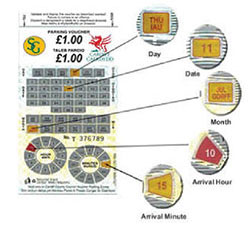
Photo. An example of a paper license used in the United Kingdom by drivers who wish to use (or keep) their vehicles within a defined area during a defined time period. The paper license shows the price of the permit and the times and dates the permit applies to.
Example of a paper license used in the United Kingdom.
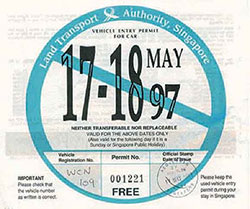
Example of a paper license used in Singapore.
Photo. An example of a paper license used in Singapore by drivers who wish to use (or keep) their vehicles within a defined area during a defined time period. The paper license shows the times and dates the permit applies to.
There are two main options for implementing paper-based schemes:
- Entry Permit Schemes: Vehicles display a valid license sticker to enter (or leave) a defined area (the restricted zone).
- True Area Licensing Schemes: Vehicles display a valid license to travel or park within a defined area.
The distribution of permits or licenses is usually managed through a combination of existing retail outlets and other system operator channels, such as vending machines, the Internet, and phone-based mail order. For tolling, coupon books have been used in a number of facilities. In the Baltimore Harbor Tunnels, a user can purchase a book of 10 coupons for paying the toll at a discounted price.
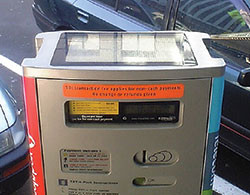
Sticker purchase machine.
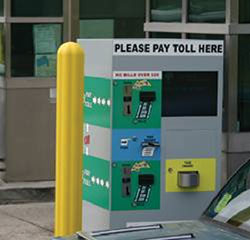
Manual toll booth.
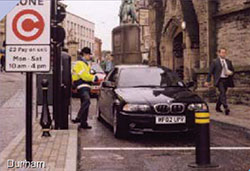
Manual toll collection in Durham City, UK.
Singapore’s Area Licensing Scheme, which operated from 1975 until 1998, required car drivers entering the CBD during the morning peak period to pay three Singapore dollars per day (with exemptions for vehicles that carried four or more people). This was managed by using a paper-based (sticker) system with stickers purchased for each day and placed on the inside of the windshield. Drivers were able to travel into and around the priced area several times a day without paying multiple charges. Enforcement was addressed at checkpoints where officials inspected each vehicle to ensure a valid license was displayed.
Street-based equipment is generally provided for the distribution of permits or licenses. The need for and location of permit or ticket vending machines vary by system but in most cases can be installed to suit the local environment. More advanced units can be installed with built-in mobile communications and solar power units, which require no direct connections to street services.
Manual-Toll Facilities
Manual-toll facilities, toll booths, or plazas have been used around the United States and the world for many years and comprise payment points at which drivers pay a charge by using cash, vouchers, charge cards, credit cards, or smart cards. Some of these manual-tolling systems are still in use today. Replacement modern versions have changed little in that a manual-toll terminal or cash register is used to collect and record the toll or charge while a traffic light and automatic boom gate hold the car present in the toll lane until payment is made. At one time, on facilities such as the Pennsylvania Turnpike, New York State Thruway, New Jersey Turnpike, Florida Turnpike, and Kansas Turnpike, a driver encountered a toll booth upon entry and exit. A paper ticket was provided on entry to record the start of the trip on the turnpike, and it was used upon exit to charge the driver for the distance driven on the road.
Because of (a) the amount of space required for conventional toll booths in dense urban road networks, (b) the congestion caused by the need to slow down or to stop to pay, and (c) the associated negative public perceptions, this method is generally not considered appropriate for urban pricing. Automated payment machines have helped reduce the costs of manual collection.
One of, if not the only, manual-based congestion charge schemes in operation is the Durham City, United Kingdom (UK), scheme implemented in 2002, which uses a system of bollard gates and manual payment machines. Drivers are required to pay the designated charge when exiting the city center zone before the bollard gate will open. These gates are manned by an official, and drivers who are unable to pay are allowed to pass but incur a fine.
The street-based equipment required for a manual system includes charging booths, additional lanes to increase throughput, gates at all entry points, sufficient space to install the required equipment, and access to power and communications.
Image-Based Tolling/Automatic License Plate Recognition (ALPR) Technology
ALPR technology is commonly used on most electronic tolling facilities around the world, both in free-flow and toll-lane-based situations, although most often it is used as an enforcement backup to dedicated short-range communications (DSRC) or vehicle-positioning system (VPS) technology.
ALPR is based on images taken of vehicle license plates, which are then processed through optical character recognition software to identify the vehicle by its license plate. Some systems use front- and rear-located cameras to capture the images to improve identification rates. Once identified, the required charge or permit-checking processes are undertaken in a similar way to other systems.

Example of ALPR image.

Typical ALPR camera and illumination device.
A key issue with ALPR facilities is the level of reliability of the images. The best systems are capable of read rates of around 98 percent in good conditions, but this can be reduced as a result of light reflections in the image or dirty or damaged plates. This leads to the need for manual checking of those plates and can add significantly to processing costs.
The London Congestion Charge, an area-licensing scheme, is the only scheme that currently relies entirely on ALPR on a large scale as an enforcement system. Several other toll facilities provide ALPR-only account options to users, but most require additional administration fees to compensate for the increased cost of processing these types of transactions. The London scheme also requires ALPR stations within a designated zone, at fixed locations, and on mobile enforcement units.
In the United States, most ALPR systems have been used on toll roads for payment violation enforcement, but this is changing. As toll facilities move to cashless open-road tolling, they are using ALPR systems as a tolling account rather than tags or DSRC transponders. Denver’s E-470 and Tampa’s Selmon Expressway are two examples where ALPR is used extensively to record the toll transaction. In Toronto’s 407 toll facility, drivers can use either tags or their license plate as identification for paying the toll.
The roadside- or street-based equipment required for an ALPR system would include pole and/or gantry-mounted cameras and illumination devices. In some cases, these are combined into one unit. Depending on the overall system design, there may be a requirement for additional cameras (front and rear), classification devices, and independent verification. In addition to the camera mountings, some form of system controller would be required near each installation, requiring full power and communication connections via a purpose-designed base unit connected to each camera location. Communications connections may need a dedicated or leased fiber-optic network, and the power supplies may need an uninterruptible power supply.
DSRC Free-Flow Toll Using Transponders and Gantries


Components of Singapore's ERP system.

Example of vehicle positioning system.
DSRC is the most common form of primary electronic congestion-pricing technology in general use and is the standard on most free-flow toll facilities. The technology is based on on-board units (OBUs), sometimes referred to as tags or transponders, which communicate with gantry-mounted equipment at checkpoints. The roadside equipment identifies and verifies each vehicle’s OBU, and depending on the type of system, either processes a charge from its designated account or confirms its rights of access. In most multi-lane free-flow systems, the DSRC system also acts to locate the vehicle within its detection zone by using an array of DSRC transceivers. Combinations of toll points can be used to facilitate distance-based charging systems, with special charging conditions for particular entry and exit points or times. The enforcement of this type of scheme is generally addressed by using roadside enforcement cameras and ALPR technology.
DSRC tolling started in the United States at the North Dallas Toll Road. It became the harbinger for electronic toll collection (ETC) that has grown rapidly around the world. These early single-lane ETC facilities can still be found in New York City at the Port Authority of New York–New Jersey bridges and tunnels and on the San Francisco Bay area bridges and tunnels. Multiple lane, free-flow, or open road tolling (ORT), removed the toll booth and single lanes and combined ETC for two or more lanes at facilities in Oklahoma, Denver’s E-470, and most of the Orlando–Orange County expressway system.
There is a range of DSRC systems in use and under development. Some use infrared communications; this technology has not been deployed widely in higher speed applications and is not generally considered as an open standard. Most are based on microwave communication. The most common systems currently in use are based on a 5.8-GHz frequency, using the European CEN-278 standard. This standard is now well developed and delivers robust and secure OBU devices with an average battery life of around 5 years.
The next generation of 5.9-GHz systems, which are being developed mainly in the United States to address a wider spectrum of intelligent transportation systems (ITS) applications, will provide longer range communication and multiple channels. Although not currently in use on any operational pricing system, these OBUs are planned to become standard installations in all new vehicles within the next decade.
DSRC systems can be expanded relatively easily onto other routes or across adjacent areas through the deployment of additional toll or check points. However, expanding these types of systems to cover much wider areas is less cost-effective, because the numbers of toll points to provide effective coverage can increase significantly.
The street-based facilities required for a DSRC system include a range of equipment, such as pole- and/or gantry-mounted transceivers, ALPR cameras and illumination devices, vehicle-classification devices, independent verification devices, and roadside control cabinets.
In the urban environment, some street layouts may require modifications to improve the operation of the system (e.g., to provide localized separation of traffic from opposing direction streams and to assist in reducing the need for full gantries in street situations). The transceiver/classifier units are generally mounted separately from the cameras to allow the cameras to detect vehicles in the pricing zone, although technologies are available to combine all functions at one location. A further variation in some arrangements is the use of front and rear cameras, which may require an additional camera support structure.
Some form of system controller would also be required in the vicinity of each installation, requiring full power and communication connections via a purpose-designed base unit connected to each location.
In multi-lane situations, an array of transceivers and classifiers will be required, generally mounted on purpose-built gantries or potentially mounted on existing structures. Where multi-lane facilities are to be installed in two directions, the relative location of gantries also requires consideration, because a degree of separation is required between some equipment.
Singapore operates an ETC system as its primary technology for congestion pricing. Groups (arrays) of transceivers mounted on entry-point gantries communicate with units in each vehicle to locate the vehicle and record the transaction. The OBUs are also equipped with smart card payment facilities.
In Italy, several major cities operate access control systems that use the TELEPASS toll system, which was developed and has been operating on the Italian motorway network. This system is based on the use of 5.8-GHz transceivers and OBUs and is designed for use in single-lane toll-gate situations only.
VPS Technologies
Internationally, road authorities have been exploring and implementing VPS (e.g., global positioning system [GPS], Galileo, Global Navigation Satellite System [GLONASS]), which do not require on-road infrastructure to assign a position to a vehicle. Instead, these systems use satellite-location systems, generally GPS, to determine the vehicle’s position and to measure location and distance travelled for the purposes of charging and access control. These systems offer greater flexibility for authorities to vary charges to influence more aspects of travel and transportation choice. In Europe, the launch of the Galileo satellite system will complement the U.S. GPS system with over 30 more satellites in orbit, ensuring greater accuracy of position and location. The Russian GLONASS is currently being renovated and will add 30 more positioning satellites in orbit by 2015. In total, the fleet of positioning satellites, GPS, Galileo, and GLONASS will provide nearly 100 total satellites for positioning and navigation systems that will be accurate to less than 3-feet positioning in the next 5 to 7 years.
Although VPS technologies are an effective means of tracking vehicle position, the information they gather and store needs to be communicated to central systems on a regular basis, and as such, VPS units are generally combined with other technologies (e.g., digital maps, wide-area communications, and short-range general packet radio service [GPRS] communications) to charge and enforce the system. Additional features required include enforcement checkpoints (fixed and mobile) and depending on the focus of the system, these can be extensive. New DSRC systems such as the 5.9-GHz technology along with Wireless Fidelity (WiFi), Worldwide Interoperability for Microwave Access (WiMAX), and other third-generation communications capabilities that are being implemented in Baltimore and in other cities across the United States will make VPS more popular for navigation, tolling, and congestion pricing.
The current cost of units has been a major factor in these systems that are only being used for heavy-vehicle application to date. Once established, VPS-based systems have the advantages of wide coverage and far fewer checkpoints than do other technologies. It is expected that on-board VPS units will become standard features in new vehicles within 10 years; this migration is a specifically identified strategy for the European Union.
VPS-based systems require far less on-street equipment than do other systems, with the primary function of the street-based facilities being backup enforcement at selected checkpoints. Fixed on-street checkpoints are most likely to use DSRC and ALPR technologies that require a series of pole- or gantry-mounted devices. These fixed enforcement stations will most likely be supported by mobile units that will reduce the number of locations required.
VPS-type technology is in use on several wide-area, heavy-vehicle, road-user charging facilities, including systems in Germany and Switzerland. VPS-based systems have been introduced or considered (in the United Kingdom) as technology solutions for the introduction of distance-based charging, primarily for heavy vehicles. The German model is beginning to demonstrate that the technology is moving toward being “proven,” but only for a distance-based charge.
Nowhere in the world has VPS been used for a more contained urban-congestion-pricing scheme, primarily because of difficulties in receiving signals from satellites in the urban environment (with its canyon effect) and because the higher costs of in-vehicle units are prohibitive in smaller areas. In an urban area, the costs of the scheme would also likely rise dramatically because of the need for “repeater” units to overcome the canyon effects and improve boundary accuracy. Similar systems have been used in Seattle for testing driver responses to tolling. Portland, Oregon, also ran a test with such a system in which drivers could pay the distance charge rather than pay a higher excise tax for fuel at the pump. The pilot test indicated that such a concept could act as a transition approach to moving away from fuel excise taxes to distance-based charges.
Cellular Telephone and Pico-Cell Systems
A cellular network is basically a radio network made up of several radio cells, each served by a fixed transmitter that is known as a cell site or base station. These cells are used to provide radio coverage over a wider area. Cellular networks use a set of fixed main transceivers, each serving a cell and a set of distributed transceivers, which provide services to the network’s users.
Pico-cell technology is, in simple terms, a more concentrated cell network that uses smaller transceivers and thus develops a cell network that provides a greater ability to locate mobile devices within the network. By using this type of network, it is possible to locate properly equipped vehicles with a high degree of accuracy, thus providing the potential to introduce distance-based charging by using a ground-based technology. The sensor networks being developed for this type of application consist of a large number of devices (known as motes) that are connected by using wireless technology.

Pico-cell data transmission illustration.
Recent trials in Maryland and California have involved the cellular network to gather traffic data based on a static network of motes connected to bus stops and mobile motes placed on buses, which become transient members of the static network as they approach a bus stop. The system trials have been used to provide position information collected from the buses. Future intelligent infrastructure pico-cell systems are based on the concept of a dense network of low-cost short-range transceivers located within vehicles and on roadsides.
Trials of this type of technology have recently been undertaken in the United Kingdom (Newcastle and London) to test the feasibility of this technology for congestion pricing. These trials have indicated that this type of technology does have the potential to provide a viable alternative to other location-based systems such as VPS.
The street-based equipment required for this type of system includes an extensive network of short-range communications devices that make up an integrated web of communications. These devices would be located in vehicles and as part of roadside infrastructure and would have minimal impact in terms of space or visual intrusion.
As with VPS-based systems, this type of system would require some on-street enforcement, although far less than other systems, with the primary function of the street-based facilities being backup enforcement at selected checkpoints. Fixed on-street checkpoints are most likely to use DSRC and ALPR technologies and require a series of pole- or gantry-mounted devices. These fixed enforcement stations would most likely be supported by mobile units that would reduce the number of locations required.
Combination Systems
The majority of current pricing systems, including toll roads and urban charging and access schemes, use a combination of technologies to manage the collection and enforcement process. This includes almost all U.S. toll roads from Maine to Florida and from New York City to San Francisco.
One of the most common combinations is the use of DSRC OBUs as the primary payment and identification technology and ALPR technology for enforcement and casual-user transactions. This combination allows operators to benefit from the higher accuracy and lower operating costs of DSRC, while using ALPR to overcome DSRC limitations of casual-user management and enforcement. This package also limits the use of the less accurate and more operations cost-hungry ALPR technology to a reduced number of transactions.
Other global example combinations include the deployment of VPS on the German and Swiss truck toll systems, which use VPS to address the distance- and location-based elements; DSRC to provide the necessary local roadside communication; and ALPR as a base-enforcement technology.